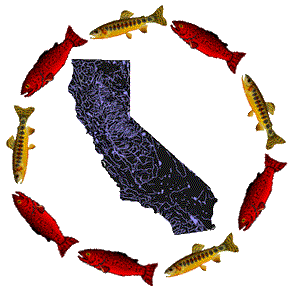CSPA |
| “Way too many of these fish died long before they ever got to the ocean. Way too much water is now being taken out of the river and we are just not getting enough actual water back in the system for salmon to survive -- we only get promises of water. But fish swim in water, not promises.” Zeke Grader, executive director of the Pacific Coast Federation of Fishermen’s Associations |
| Your 501(c)(3) tax deductible cash donations are desperately needed if the fight for our fisheries is to continue. Read how you can donate! |

 More News
More News
![]()
Salmon Disaster Relief Application Deadline Is December 31
by Dan Bacher, editor of the FishSniffer
December 22, 2008 -- The California Salmon Council is trying to locate businesses harmed by the 2008 salmon season closure that may be eligible for federal disaster relief. The deadline to file for aid is December 31.
This year's salmon season closure, caused by the collapse of the Sacramento River fall chinook salmon run, has been devastating to commercial fishermen, commercial charter boat operators, Sacramento in-river guides, fish processors and other salmon-related businesses. The California Department of Fish and Game (DFG) assessed the potential loss from the closure of the salmon season to be $255 million and 2,263 California jobs.
In response to the unprecedented coast wide closure, Congress appropriated $170 million for disaster relief to be disbursed to the fishing communities in California, Oregon and Washington. Representative Mike Thompson (D-Thompson) championed the disaster relief bill with assistance from other West Coast legislators – and stopped an attempt by the Bush administration to divert $70 million of the salmon disaster money to pay for the U.S. Census.
“Salmon-related enterprises that require a Department of Fish & Game (DFG) license to operate have been sent disaster forms,” according to a news release from the Council. “Eligible businesses that cater to commercial or recreational anglers that are not regulated by the DFG may not be aware of the disaster relief program and will need to file an application for relief before the December 31 deadline.”
Eligible businesses must demonstrate that salmon is at least 30 percent of their normal business. They must also provide documentation indicating their loss up to a maximum of $225,000.
The National Marine Fisheries Service (NMFS) has repeatedly cited "poor ocean conditions" as a major factor in the Central Valley salmon collapse. While ocean conditions clearly played a role, recreational anglers, commercial fishermen, Indian Tribes, environmentalists and independent scientists have pointed to record and near-record water diversions from the ecologically fragile California Delta in recent years as adding additional and unnecessary stress on young salmon as they migrate out to the ocean.
“Way too many of these fish died long before they ever got to the ocean,” said Zeke Grader, executive director of the Pacific Coast Federation of Fishermen’s Associations, after Secretary of Commerce Carlos M. Gutierrez issued a fishery disaster declaration of May 1, 2008. “Way too much water is now being taken out of the river and we are just not getting enough actual water back in the system for salmon to survive -- we only get promises of water. But fish swim in water, not promises.”
Disaster relief forms may be obtained online from the California Salmon Council website at http://www.calkingsalmon.org or the Pacific States Marine Fisheries Commission website at http://www.psmfc.org.
For more information about the 2008 Salmon Federal Disaster Relief Program contact the following organizations:
California Salmon Council - 916-933-7050, http://www.calkingsalmon.org
Pacific States Marine Fisheries Commission - 877-695-3457, http://www.psmfc.org